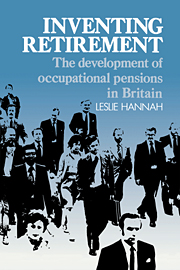Epilogue: Contemporary critics and the future of pensions
Published online by Cambridge University Press: 03 May 2010
Summary
We knew how to make our predecessors retire. When it comes to forcing our own retirement, our successors must find some method of their own.
C. Northcote Parkinson, Parkinson's Law, 1958, p. 122In the 1980s, the return of mass unemployment on a level not experienced since the 1930s, and the radicalization of politics on both right and left, have changed the focus of the pension debate. Many employees once in pension schemes have been thrown out of both schemes and jobs, with early retirement on pension sometimes used as a means of alleviating the resulting hardship. Between 1979 and 1983, membership of occupational pension schemes declined from 11.8 million to 10.9 million: roughly in line with the fall in employment. The percentage coverage among those full-time employees retaining jobs has remained roughly constant. The coverage of full-time women employees has increased to the same level as that for men, and the coverage of the ‘core’ work force has shown no signs of receding. More than three-quarters of males over the age of twenty-five are now in occupational pension schemes. Moreover, with improved vesting of pension rights, those who did not maintain stable employment patterns will still accumulate pension rights. Whereas barely a third of retirees drew occupational pensions before compulsory vesting, this proportion is rapidly rising to two-thirds and over. Moreover, women, who form the majority of the old, are now increasingly benefiting from their husbands' schemes through the spread of widows' pensions.
- Type
- Chapter
- Information
- Inventing RetirementThe Development of Occupational Pensions in Britain, pp. 138 - 144Publisher: Cambridge University PressPrint publication year: 1986



